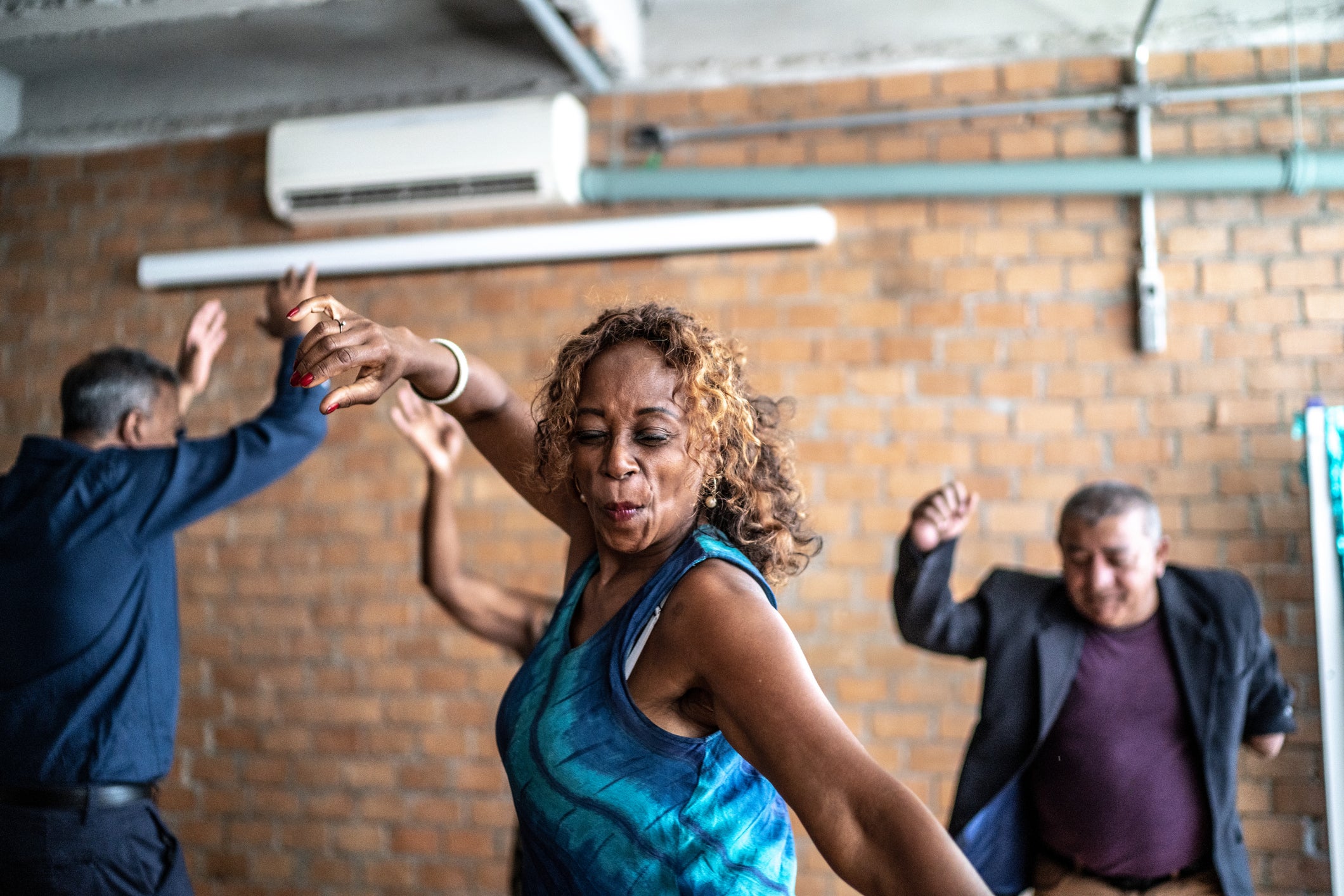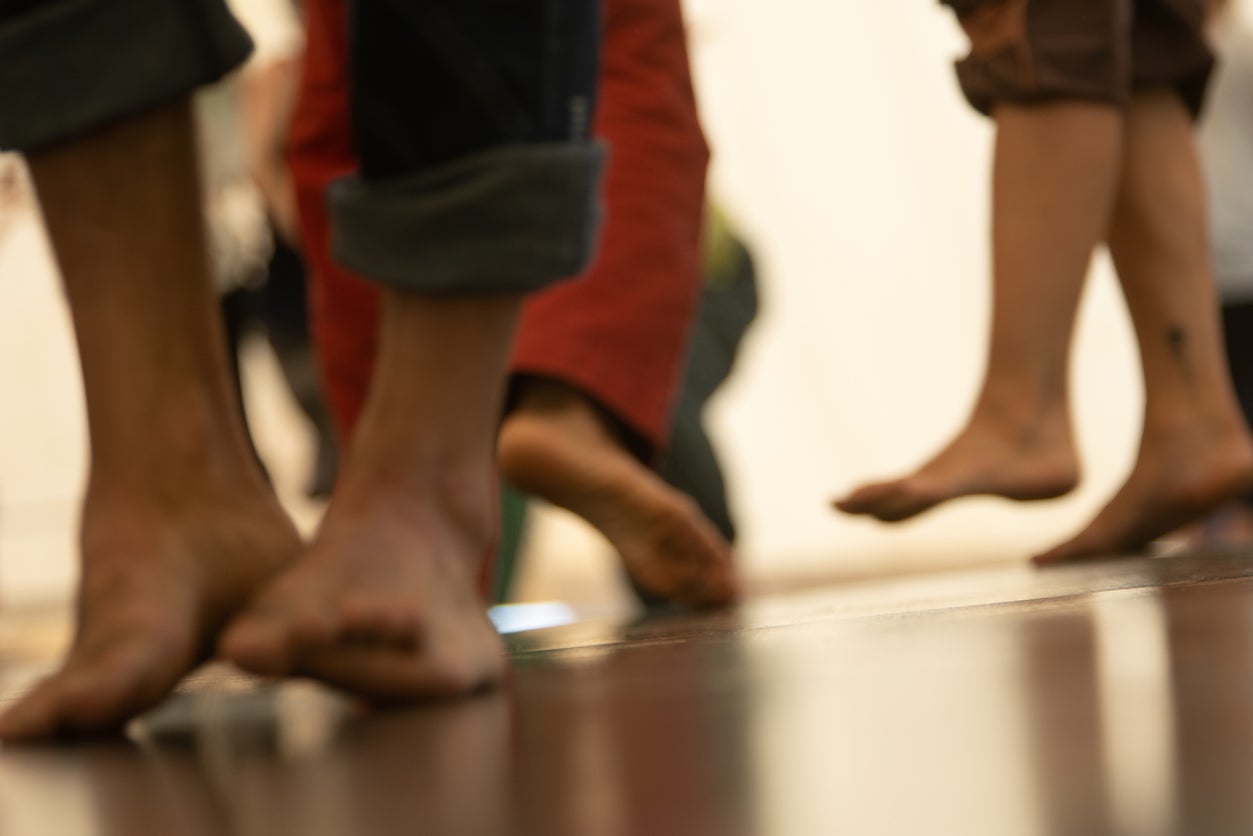I tried ecstatic dance to see if it’s the ultimate therapy
As new research shows that dance could be the best cure for depression, Helen Coffey attempts to sashay her troubles away through free-form expressive movement


Right. Are we ready for this?” asks my friend, looking me dead in the eye. We’re still in the car. We could still back out. I shake my head.
“Probably not. But we’ve come this far.”
We’ve come, in fact, to a village hall in the middle of nowhere on a Saturday morning to try something neither of us has ever done before: ecstatic dance. Not to be confused with any kind of standard workout – this ain’t no “body pump” class encouraging you to do an embarrassing approximation of a twerk, while clad in extortionately overpriced Lululemon athleisure wear. This is, supposedly, closer to therapy.
And it couldn’t be a more apt time to try it than in the wake of recent research revealing that dance is one of the best cures for depression on the planet. Australian researchers published a study in The BMJ in February 2024 showing that the most effective form of exercise when it came to reducing depression symptoms was dancing, surpassing walking, jogging, yoga, tai chi and strength training. Not only that, it also trumped cognitive behavioural therapy (CBT) and selective serotonin reuptake inhibitors (SSRIs).
I wasn’t in the least surprised when I saw those results. I’ve tried nearly every form of dance at one point or another, from ballet and Irish dancing as a kid (the latter earning me a guest appearance on The Generation Game, the undisputed highlight of my media career) to tap, disco, street and Latin in my teens. During my drama degree, I took an entire module in interpretive dance, led by a slightly unhinged choreography tutor who once subjected us to an hour-long “performance” using only her eyebrows. I now spend my Tuesday evenings in a sweaty room full of menopausal women doing Zumba at my local sports centre. And, at the age of 37, I still go on regular Big Nights Out and book festival tickets just so I can dance for hours with impunity.
But I still remember the first time I fully understood that dancing was more than just a fun pastime. In my early twenties, I’d suffered my first ever proper heartbreak after a sudden dumping. There is very little that’s as painful as that initial time. Age and life experience really do dull the sting; the battle scars build up and, while partings still hurt, it is never quite the same searing, white-hot agony as that exacted upon a soft and unblemished heart. Cat Stevens perhaps put it best when he sang “The first cut is the deepest.”

So, you get the picture. I was grief-stricken, with all the classic accompanying symptoms: insomnia, lack of appetite and, worst of all for a pathologically upbeat person, anhedonia – the inability to take pleasure or even muster up interest in anything at all. This didn’t shift for over a month until, one day, I was listening to music while sunlight streamed in through the window – and I suddenly had the urge to dance. I was present in my body for the first time in weeks. There was no conscious thought, only the deep-rooted knowledge that movement felt good. A small spark of joy that I’d thought forever doused sputtered back into life.
Fast-forward 14 years and here I am, in the village hall, preparing to join a room full of strangers and “dance out” my emotions, “I’m Just Ken”-style. This feels far less low-key than my solo epiphany – there will, after all, be witnesses.
We enter the hall, greeted by the softly spoken facilitator, Sasha, and the sight of around 10 participants rolling around on the floor and stretching as gentle music plays. I have a sudden irrepressible vision of the iconic episode of Peep Show where Mark Corrigan attends a “Rainbow Rhythms” class. “I’ve walked into my own personal nightmare,” runs his internal monologue as he enters the room. “Must remain non-uptight… Even if they make me play trust exercises with their genitals.”
Sometimes I have my eyes closed, sometimes open, and I watch with quiet elation as people around me lose themselves in music and movement
Before the session begins in earnest though, there’s an “opening circle” and introduction that helps dial down the daunted feeling. We’re told more about what ecstatic dance actually is for the benefit of us newcomers: a movement practice to explore the exhilarating feeling of moving your body freely. “If you feel inhibited at any point, we suggest you close your eyes, listen to the music and return to your breath and your body,” says Sasha. The point is to move however the music inspires you to – no thinking, just feeling. It’s tapping into something primal; the epitome of the old “dance like no one’s watching” platitude.
There are no rules, per se, other than to respect other people’s personal space and boundaries. While it is possible to dance with other people, there’s certainly no expectation of that – and you can only do so if the other person is clearly open to it.
A final note, or perhaps warning: “This practice can bring up big emotions. Although it’s called ecstatic dance, these won’t necessarily be happy – you might find feelings of anger or sadness are stirred up.” I scoff internally; I’ve never felt anything remotely like that while dancing.
And then we’re off to the races. I’d describe myself as a natural exhibitionist in many ways and I don’t feel too self-conscious. Yet, perhaps because of that, I find that I’m in my head; I’m used to dancing for an audience, to it feeling like some kind of performance. This is almost the opposite, requiring you to tune into what’s happening internally, and what the music might be prompting you to express, rather than focusing on external aesthetics.

A man behind the decks at the back handles the transitions and picks the songs. While I had been expecting hippie-esque “world” music, the selection is surprisingly eclectic. At one point, my friend and I find ourselves in the same corner of the room, delightedly strutting our stuff to a remix of Missy Elliott’s “Get Ur Freak On”. At another, a classical piano piece taps into my childhood ballet classes and I feel a wave of nostalgia wash over me as I pirouette.
Time becomes elastic; I have no sense of how long we’ve been dancing or how long we have left. I’m not sure when it happened, but the cerebral part of me has been replaced by pure instinct. Sometimes I have my eyes closed, sometimes open, and I watch with quiet elation as people around me lose themselves in music and movement.
Sometimes I feel compelled to fill the space – to travel across it, getting bigger and bigger like an ever-expanding, joy-filled balloon. Sometimes I find myself shrinking, getting low to the ground, feeling the pull of the earth. The beat drops: I am sweating; I am grinning; I look like I’ve lost the plot and I couldn’t care less.
But the truly astonishing incident happens during the penultimate number. It’s Lamb’s “My Angel Gabriel” – an evocative song that never fails to sucker punch me right in the solar plexus. The next thing I know, I’m crying. Not a solitary tear – subtle and classy – but an undeniable torrent. “Oh my God, I’m dance-crying,” I think hysterically. “Sasha was right. It’s actually happening.” It’s as if every bit of pain I’ve experienced in the last year is pouring out of my eyeballs. We’re far enough down the rabbit hole that I feel neither shame nor embarrassment. I just continue weeping silently while, yes, dancing out my feelings. It is strange, and sad, and ridiculously cathartic. There’s hurt but there’s healing. Bloody hell.
I continue weeping silently while, yes, dancing out my feelings. It is strange, and sad, and ridiculously cathartic
We finish the session with a closing circle, where we’re invited to share insights from the experience should we wish to. Again, a Peep Show “Rainbow Rhythms” reference barrels into my thoughts.
“There was a lot of new energy in the room tonight, and some of it was just so Rainbow Rhythms, and some of it was just so not Rainbow Rhythms,” says one participant during the episode.
“Well, listen, I’m sorry if I didn’t do it right and I’m sorry if you assume that I eat red meat and don’t necessarily think money or Tony Blair are a bad thing, but if there isn’t room here for people who stand against everything you believe in, then what sort of a hippie free-for-all is this?” replies Mark.
A fair point. I can’t imagine any of the people in our group being so judgemental. Still: I’ve laughed, I’ve cried, I’ve waved my hands in the air like I just don’t care and danced like no one’s watching. I’m definitely feeling so Rainbow Rhythms right now. And I’ll certainly be back for more – after all, it’s a hell of a lot cheaper than therapy.
Join our commenting forum
Join thought-provoking conversations, follow other Independent readers and see their replies
Comments